Cor Caroli is a binary star system, also designated as Alpha Canum Venaticorum, situated in the constellation of Canes Venatici.
Key Facts & Summary
- Cor Caroli is the brightest point of light in the northern constellation of Canes Venatici.
- The binary star system is situated at around 120 light-years / 40 parsecs away from the Sun. The primary star, Cor Caroli or α2 Canum Venaticorum , is closer to us, at only 115 light-years / 35 parsecs.
- The two components of Cor Caroli are α2Canum Venaticorum, and α1 Canum Venaticorum – the primary star, is also to be referred to as Cor Caroli.
- The star system’s apparent visual magnitude is 5.60, while the absolute magnitude is estimated to be at around 0.16.
- The primary star, α2Canum Venaticorum, is a chemichally peculiar star that belongs to the spectral class A0 and is classified as an Ap/Bp star.
- The secondary star, α1Canum Venaticorum, is an F-type main-sequence star of spectral type F2V.
- The radial velocity of the primary star is around -4.10 km / -2.5 mi per second, while the secondary -0.60 km / -0.37 mi per second.
- Both stars are more massive and overall bigger than our Sun. The primary star has 2.97 solar masses, while the secondary star has 1.47 solar masses.
- The primary star’s radius is around 2.49 solar radii, while the secondary star has a radius of 1.5 solar radii.
- The primary star has average surface temperatures of around 11,600 K, while the secondary star has 7,080 K.
- The rotational velocity of the primary star is estimated at around 18.4 km / 11.4 mi per second, while the secondary is 18 km / 11.1 mi per second.
- Cor Caroli along with Chara, the second brightest star in Canes Venatici, are the two most important stars in the constellation.
- The two stars in the binary system are separated by 19.6 arc seconds.
In the western world, Alpha Canum Venaticorum had no official name until the 17th century, when it was named Cor Caroli. It translates to “Charles’s Heart”.
Some believe that Cor Caroli was named after King Charles I of England, who was executed in 1649 during the English Civil War.
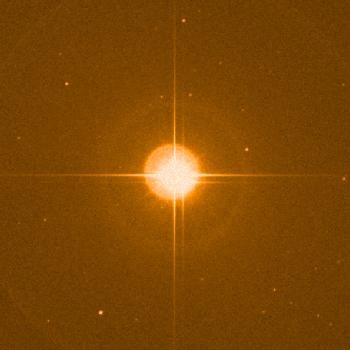
Others believe that Cor Caroli was named after Charles’s son, Charles II, who restored the English monarchy to the throne in 1660. The name was coined in 1660 by Sir Charles Scarborough, physicist to Charles II, who claimed that the star seemed to shine very brightly on the night of Charles II’s return to England.
Formation
The two stars in the Cor Caroli star system most likely formed at different periods. One of the stars is dated to be at only 165 million years old, quite young, especially in comparison to our Sun.
How the two stars came to be gravitationally bound to one another is uncertain, however, they both formed out of a molecular cloud of dust and gas. Gravity pulled the swirling gas and dust together and resulted in the brightest star of the Canes Venatici constellation.
Distance, Size, and Mass
α1 Canum Venaticorum is located at around 120 light-years / 40 parsecs away from the Sun, while α2 Canum Venaticorum is closer to us, at 115 light-years / 35 parsecs away.
α1 Canum Venaticorum is the smaller star of the pair, having 1.47 solar masses, or 147% of the Sun’s mass, and 1.5 solar radii, or 150% of the Sun’s radius. Thus this star should be around 3 times bigger than our Sun.
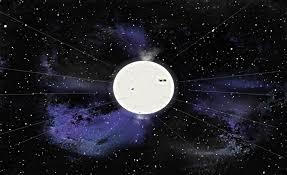
α2 Canum Venaticorum has 2.97 solar masses or 297% of the Sun’s mass, and 2.49 solar radii, or 249% of the Sun’s radius, thus the star is around five times bigger than our Sun.
Other Characteristics
α1 Canum Venaticorum is an F-type main-sequence star, much fainter than its companion, with a visual magnitude of 5.60. It has a surface gravity of 4.25 cgs, and surface temperatures of about 7,080 K. Thus α1 Canum Venaticorum is 1.2 times hotter than our Sun. The rotational velocity of α1 Canum Venaticorum is 18 km / 11.1 mi per second.
α2 Canum Venaticorum is a spectral type A0 star, with an apparent magnitude which varies from 2.84 to 2.98 over a period of 5.47 days. α2 Canum Venaticorum is a chemically peculiar star with a strong magnetic field, around 5,000 times stronger than Earth’s magnetic field.
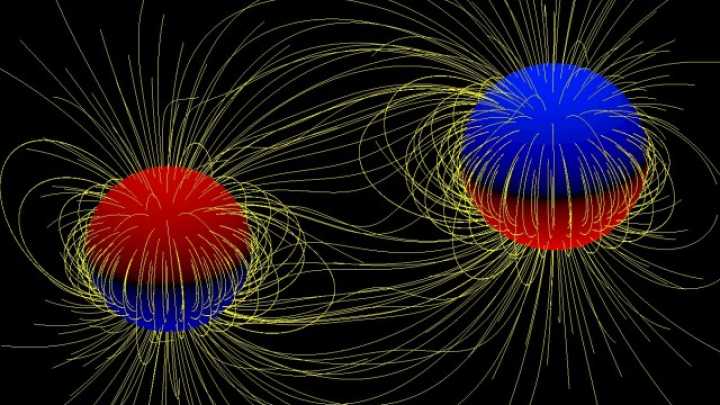
α2 Canum Venaticorum is also classified as an Ap/Bp star – its atmosphere has overabundances of certain elements, such as silicon, mercury, and europium.
The reason for this is that some elements are sinking into the star under the force of gravity while other elements are elevated by radiation pressure.
α2 Canum Venaticorum is a prototype of a class of variable stars, named α2 Canum Venaticorum Variables. The strong magnetic fields of these stars are believed to produce starspots of enormous extent. Their spots are responsible for the brightness variations as the star rotates.
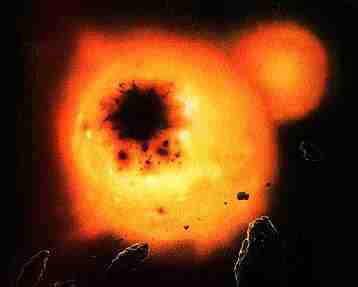
α2 Canum Venaticorum has a surface gravity of 3.9 cgs, and it is around 101 times brighter than our Sun. The average surface temperatures are around 11,600 K, which is two times hotter than our Sun.
The rotational velocity of α2 Canum Venaticorum is 18.4 km / 11.4 miles per second. It completes one rotation upon its axis in 5.4 days.
Stellar System
The Cor Caroli star system has a combined magnitude of 2.81. The two stars are 19.6 arcseconds apart / 675 AU from one another. Through small telescopes the two stars can be resolved.
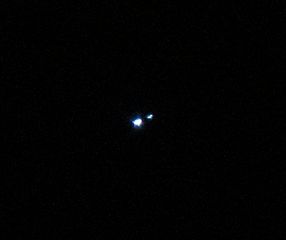
The two components orbit around a common center of mass. They complete one orbit around one another once every 8.300 years or so.
Location
Cor Caroli is situated in the constellation of Canes Venatici, the celestial hunting dogs. It is the brightest star in the constellation, the second being Chara.
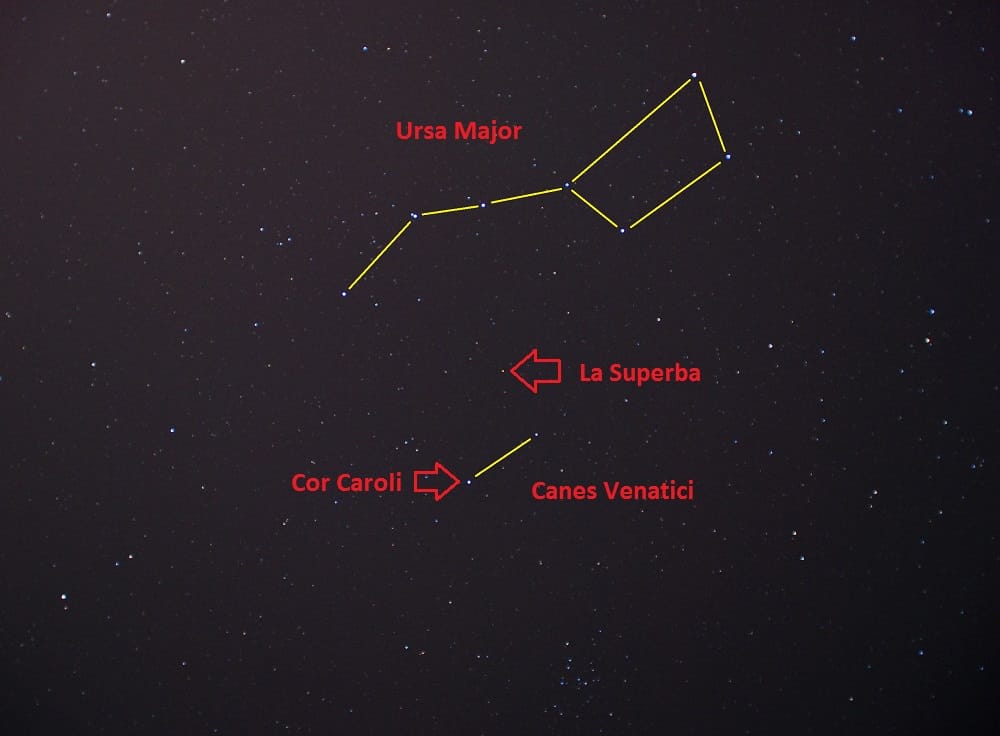
Both Cor Caroli and Chara, despite their brightness, are easily observed in the night sky due to their relationship to the famous Big Dipper asterism, which is ascending in the northeast on spring evenings. The two stars parallel the two end stars in the handle of the Dipper.
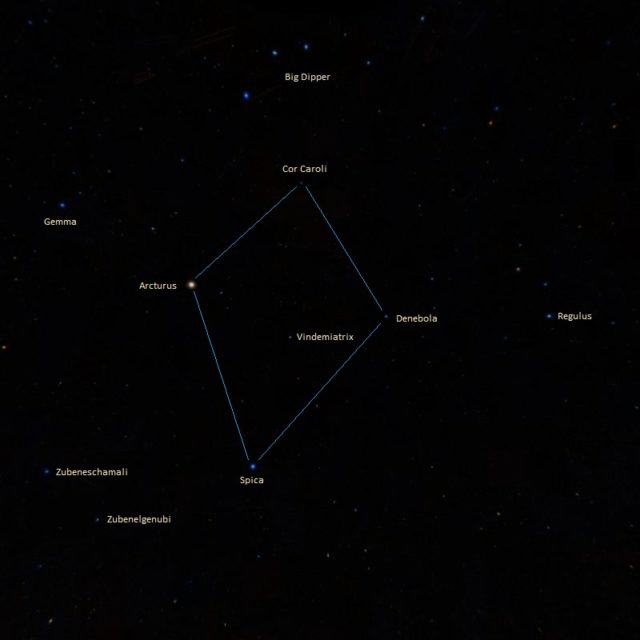
Cor Caroli marks the northern vertex of the asterism known as the Great Diamond or the Diamon of Virgo. The constellation of Canes Venatici lies in the northern hemisphere, occupying an area of 465 square degrees.
Canes Venatici is the 38th largest constellation in the night sky, located in the third quadrant of the northern hemisphere. It can be seen at latitudes between + 90 and -40 degrees.
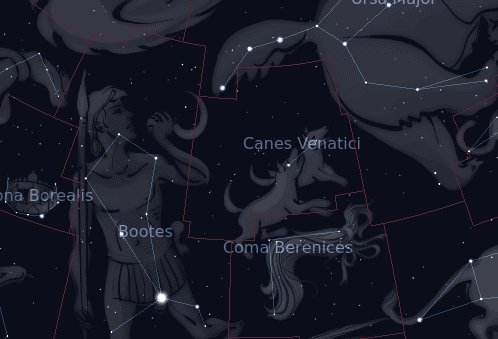
Canes Venatici has only one star brighter than magnitude 3.00 and two stars located within 32.6 light-years / 10 parsecs of Earth. The nearest star, DG Canum Venaticorum is only 25 light-years away from us. The constellation also has four stars with known exoplanets.
The Future
Cor Caroli will continue to survive for many more millions of years. Its chemically peculiar component makes future assessments difficult due to its rare nature and limited studies upon them.
Did you know?
- The Chinese know Cor Caroli as Chang Chen – the First Star of Imperial Guards – Imperial Guards being an asterism formed by Cor Caroli, 10 Canum Venaticorum, Beta Canum Venaticorum, 6 Canum Venaticorum, 2 Canum Venaticorum, and 67 Ursae Majoris.
- Canes Venatici is a very small constellation, however, it is part of the 88 official modern constellations.
- An extremely large void called the Giant Void, is located within the vicinity of Canes Venatici.
Sources:
Image Sources:
- https://jumk.de/astronomie/img/cor-caroli.jpg
- https://encrypted-tbn0.gstatic.com/images?q=tbn%3AANd9GcRldCINeZpDGUAzZyNt6gSlq4TawZgNeeIcTPuVaRYAAtQFDEal&usqp=CAU
- https://cdn.iflscience.com/images/91ea5f2b-b55d-5797-bdf8-5937084c75ef/default-1464367593-2336-phd-student-finds-two-massive-stars-with-magnetic-fields-in-a-binary-system.jpg
- https://www.daviddarling.info/images/RS_Canum_Venatocrum.jpg
- https://upload.wikimedia.org/wikipedia/commons/thumb/8/84/Cor_Caroli_2011-03-01.jpeg/286px-Cor_Caroli_2011-03-01.jpeg
- https://www.universetoday.com/wp-content/uploads/2013/05/La-Superba-Wide.jpg
- https://www.constellation-guide.com/wp-content/uploads/2016/05/Virgo-Diamond-640×640.jpg
- https://in-the-sky.org/images/constellations/con_CVN_000.png
